The yard for red phone boxes that ring no more
- Published
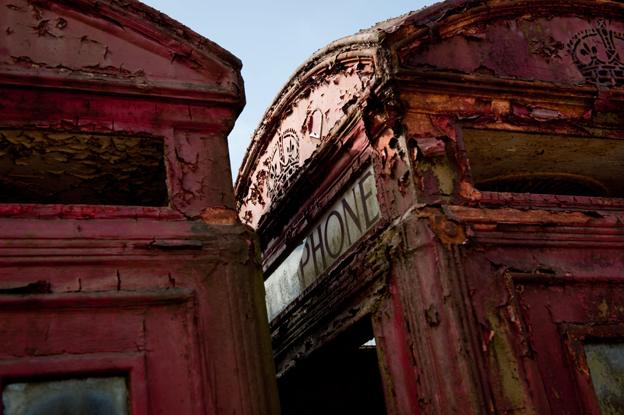
The red telephone box is a much-cherished symbol of Britishness. But most have been removed from the nation's streets, with more due to disappear. Where do they all go?
They're battered, rusting and flaky, some having stood in the sun, rain, wind and snow without any attention for three decades.
A few have weeds poking through gaps that once housed glass panels. Row after row of retired red telephone boxes remain in a yard near Merstham, Surrey, awaiting their fate. In a few weeks, maybe a few years, they will begin an afterlife - abroad, or, more likely, in British gardens.
Staff at Unicorn Restorations spend up to 30 hours stripping old kiosks, repainting them in the same shades of red once stipulated by the General Post Office and putting in new glass. Finished booths are packed into wooden crates, looking a little like enlarged coffins, for shipping. "The re-animated corpse emerges from a case at the other end," jokes Christian Lewis, the company's restorations manager.

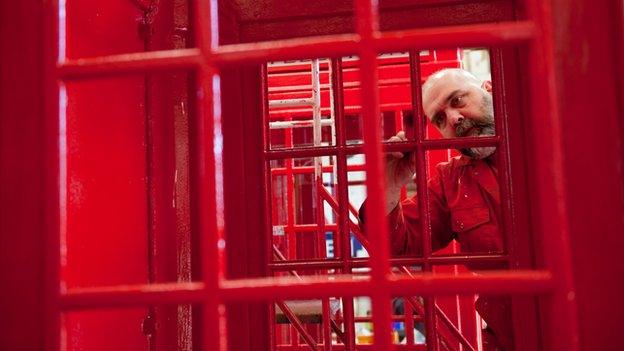
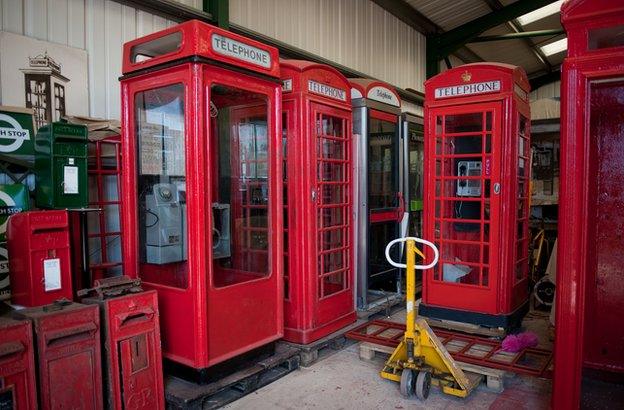
In 2002 there were 92,000 BT payphones across the UK. Today 57,500 remain, of which just 9,400 are traditional red models. Mobile phones mean most of those are now little used.
Yet they still inspire affection. The classic red kiosk was voted the greatest British design of all time, external earlier this year, beating the Routemaster double-decker bus and the union jack into second and third places.
"I think the appeal of the red telephone box is based on two things," says design critic Stephen Bayley, external. "First, the very pleasing neo-classical proportions and details which, in some mysterious way, are always satisfying wherever they are found. Second, perhaps at another unconscious level, it reminds us of a moment, alas long passed, when public service companies maintained a notion of civic responsibility - and used beauty and utility to meet that end."
There are about 70 red phone boxes in the Merstham yard. Costing between £2,000 and £10,000 when fully restored, they are not a cheap adornment. Renovated boxes have gone to Greece, Australia, Italy, France, Switzerland, Abu Dhabi, external and the US.
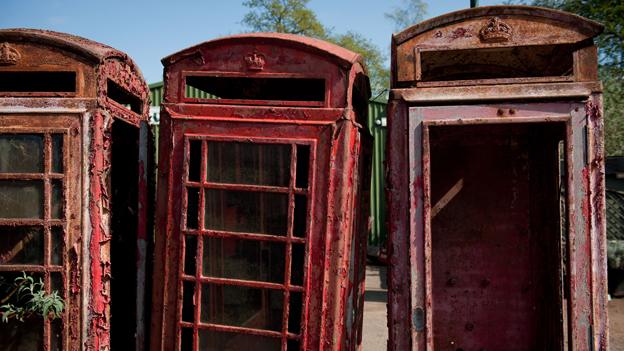

One resides on the fourth floor of a Manhattan office building, a British theatrical agent having bought it. China and Russia are growing markets, but the UK remains the biggest.
"They're a reminder of a time when things were built to last and to show the pride people had in their communities and the things that they had to share, including public telephones," says Lewis.
"Up to 90 years later they're still standing. Everyone in the world knows them. If you went to New York and didn't see a yellow cab, it would be a total let-down. It's the same with red phone boxes if someone came to visit Britain."

The designer of the red phone box
Sir Giles Gilbert Scott (1880-1960) designed the GPO's K2 and K6 - the most famous models of phone box
The design was classical, and the domed roof is thought to have been influenced by the tomb of Sir John Soane in St Pancras Old Church, near Kings Cross in London
Born to an architectural dynasty (his grandfather designed the Albert Memorial; his father masterminded Dulwich College), Gilbert Scott was also responsible for buildings such as Liverpool Anglican Cathedral, Battersea power station and Bankside power station - now the Tate Modern
Gilbert Scott's prototype design for the phone box can be found under the left arch at the entrance to the Royal Academy in London

Many of the red boxes, the most common of which is the K6 model, external, were decommissioned in the mid-1980s when newly privatised British Telecom, external replaced them with the aluminium-framed KX100, external.
In 2012, BT again began selling them off. "Numbers of red and modern kiosks are set to continue to shrink, as we cut their numbers to match demand," a spokesman says.
Telephone kiosks first appeared in the 1900s, external. These were usually inside shops and hotels, providing a quiet area from which to make calls.
Localised designs for outdoor kiosks came into use, but it was not until 1921 that the first standardised version, the cream-coloured K1, external, was used. In 1924, the General Post Office (GPO) ran a competition to design a new uniform kiosk. The winner was Sir Giles Gilbert Scott's K2, external, the first one made currently standing outside London's Royal Academy of Art, external.
It was said to have been inspired by the tomb in St Pancras, London, of the architect Sir John Soane, external, who designed the Bank of England. Square-based, it has a similarly rounded roof.
But the K2, which stood 9ft 4in (2.8m) tall and measured 3ft 6in (1m) wide, was considered expensive and unwieldy. The GPO tried various other types until Gilbert Scott's update, the K6 - which most people would today consider the traditional phone box - appeared on the streets in 1935. After a few modifications to prevent vandalism, a total of 70,000 were made. Wooden-doored, standing 8ft 4in (2.5m) tall and measuring 3ft (0.9m) wide, they weigh around three-quarters of a tonne (1,650lb), necessitating a crane to move them.
"They don't blow away and they don't dissolve," says Lewis. "The concrete underneath often weighs about half a tonne (1,100lb) too."
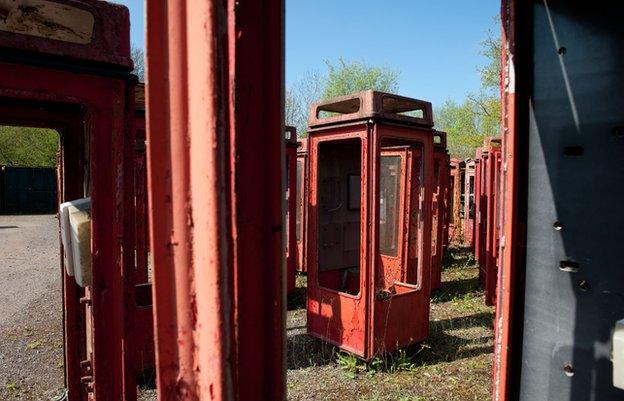
In 1968, the more modern-looking K8, external - with three large single panes of glass, rather than the small barred windows of the K6, which became a target for vandals - came into use. At first it was painted yellow, but this didn't catch on and it moved to red.
Throughout the great period of telephone box innovation there were variants, highly sought by collectors today. One was 1925's K4, external, which had a stamp dispenser at the back. Only 50 were made. The five remaining examples have Grade II heritage status, as have the K2s, which are also highly sought after because of their rarity.
Not all red phone boxes end up in restoration yards, of which there are several around the UK. In fact, Lewis says the supply is dwindling, which is likely to push up costs for collectors.
Part of the reason is BT's Adopt-a-Kiosk scheme, external, in place since 2012, which allows councils and charities to purchase a red phone box for £1, ensuring it stays in place.
Several now house defibrillators. Two phone boxes near Brighton's Pavilion have been turned into a street cafe, external. Villagers in Draughton, North Yorkshire, used a vacant red box, as a replacement when the local shop closed, external down. It operated on an "honesty" basis, users leaving money after taking goods stored inside.
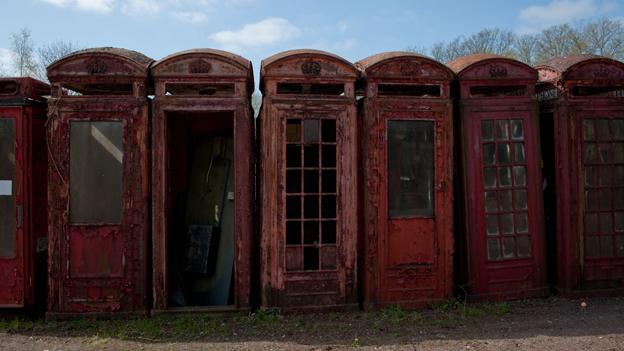
Another, in Shepreth, Cambridgeshire, became a temporary pub called - with a nod to cockney rhyming slang - the Dog and Bone in 2011 in protest at another venue, the Plough, closing. One in Marton-cum-Grafton, North Yorkshire, became a library, external.
And the greenhouse-like qualities of a red box in Knipe, Cumbria, allowed villagers to use it to grow tomatoes, external. Others in central London have been used as mobile phone-charging points, powered by solar panels on the roof.
"It's great what they're doing to keep them in use," says Lewis. "If you wanted a three-foot square space on a pavement to set up a business or anything else, you'd never get planning permission. It provides a great vantage point, because it's so distinctive and visible."
The red phone box had its own exhibition in 2012, external in London to commemorate the 25th anniversary of the charity Childline, one converted into a sofa, external and another altered into the shape of Big Ben's tower.
"They used to be the only way lots of people could use a phone," says Lewis. "For a long time you had to go on the waiting list to get a home phone, so seeing a phone box was reassuring. You used to have to queue to use them, though."
Photographs by Phil Coomes
Subscribe to the BBC News Magazine's email newsletter to get articles sent to your inbox.